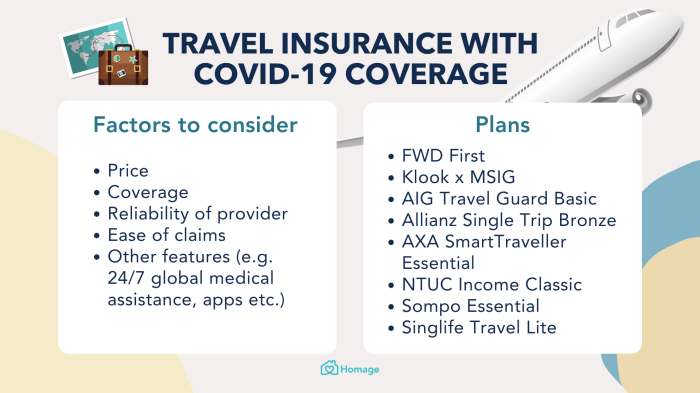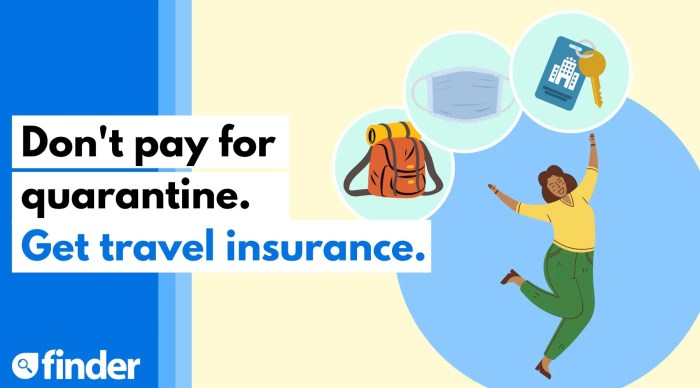
Navigating international travel in the post-pandemic world requires careful consideration of unforeseen circumstances. The emergence of COVID-19 significantly impacted travel planning, highlighting the crucial role of comprehensive travel insurance. This exploration delves into the intricacies of securing adequate coverage for COVID-19-related medical expenses and quarantine costs, offering insights into policy comparisons, claim processes, and strategies for minimizing risks during your journey.
Understanding the nuances of travel insurance policies, particularly concerning COVID-19, is paramount for peace of mind. This guide will equip you with the knowledge to choose the right policy, understand what’s covered (and what isn’t), and navigate the complexities of filing a claim should the need arise. We’ll also discuss practical travel tips to mitigate COVID-19 risks and ensure a smooth, safe trip.
COVID-19 Coverage in Travel Insurance

Securing adequate travel insurance is crucial, especially in the post-pandemic era. While the threat of COVID-19 has lessened, the possibility of infection or related complications remains a concern for many travelers. Understanding the specifics of COVID-19 coverage offered by different providers is therefore vital for informed decision-making before embarking on any trip. This section details the nuances of COVID-19 coverage in travel insurance policies.
COVID-19 Coverage Comparison Across Providers
Choosing the right travel insurance policy often involves comparing the coverage offered by different providers. The following table provides a comparison of COVID-19 coverage details, premium ranges, and exclusions for several hypothetical providers (note: specific coverage and pricing constantly change, and these are examples for illustrative purposes only. Always check directly with the provider for current information).
| Provider | Coverage Details | Premium Range | Exclusions |
|---|---|---|---|
| TravelSafe | Covers medical expenses for COVID-19 treatment abroad, including hospitalization and emergency medical evacuation. Also covers trip interruption if you contract COVID-19. | $50 – $150 per person | Pre-existing conditions related to COVID-19, unless specifically covered by an add-on. Activities deemed high-risk. |
| GlobalCare | Covers medical expenses for COVID-19 treatment, but with a lower coverage limit compared to TravelSafe. Offers trip cancellation coverage if government restrictions prevent travel. | $30 – $100 per person | Non-emergency medical treatment related to COVID-19, travel to high-risk areas without prior notification. |
| WorldTrek | Provides comprehensive coverage for COVID-19-related medical expenses, including repatriation. Trip interruption is covered if diagnosed with COVID-19 during the trip. | $75 – $200 per person | Travel against medical advice, failure to follow quarantine guidelines, and pre-existing conditions (unless specifically added). |
| AdventurePlus | Offers basic coverage for COVID-19 medical expenses with a lower coverage limit. Does not include trip interruption coverage related to COVID-19. | $20 – $60 per person | All COVID-19 related expenses if the illness was contracted before the trip, any expenses incurred due to self-imposed quarantine. |
Circumstances for COVID-19 Medical Expense Coverage
Generally, COVID-19 related medical expenses are covered if the illness is contractedduring* the trip and requires medical attention. This usually includes hospitalization, doctor visits, medication, and other necessary treatments. However, pre-existing conditions related to COVID-19 are often excluded unless specifically added as an optional rider to the policy at an extra cost. The policy will typically specify the conditions under which coverage applies, such as requiring a positive COVID-19 test result from a recognized medical facility.
Specific coverage details vary significantly by provider and policy.
Filing a Claim for COVID-19 Related Medical Expenses
The claim process usually begins by contacting the insurance provider as soon as possible after the incident. This typically involves providing documentation such as medical bills, test results, and a detailed explanation of the circumstances. The provider will then review the claim and determine the eligibility for coverage based on the policy terms and conditions. It’s important to keep all receipts and documentation related to medical expenses, as these are crucial for supporting the claim.
The timeframe for processing a claim varies by provider, but it’s generally advisable to submit all required documentation promptly to expedite the process. Failure to follow the Artikeld claim procedures may lead to delays or denial of the claim.
Quarantine Costs and Travel Insurance
Understanding what your travel insurance covers regarding quarantine is crucial for peace of mind while traveling. Many policies now offer some level of protection against unexpected quarantine expenses, but the specifics vary widely. It’s vital to carefully review your policy wording before your trip to avoid disappointment.
Travel insurance policies can offer varying degrees of coverage for quarantine-related expenses, depending on the specific policy and the reason for the quarantine. Generally, policies aim to mitigate the financial burden of unforeseen circumstances, but limitations and exclusions exist.
Types of Quarantine-Related Expenses Covered
The types of expenses covered under a travel insurance policy for quarantine can vary significantly. It is essential to check your policy’s specific wording to understand your coverage.
- Accommodation costs: This typically covers the cost of a hotel or other approved accommodation if you are required to quarantine in a designated facility.
- Meals: Some policies may reimburse for the cost of meals during your quarantine period, either through a daily allowance or by covering receipts.
- Medical expenses: If your quarantine is due to a medical condition, the policy may cover related medical expenses, including doctor visits and medication.
- Transportation costs: In some cases, transportation costs to and from the quarantine facility may be covered.
- Trip interruption costs: If your quarantine significantly impacts your trip, some policies may cover additional costs associated with extending your stay or changing your travel plans.
Examples of Covered and Uncovered Quarantine Costs
Understanding the nuances of coverage is key. Here are some scenarios illustrating when quarantine costs might be covered or excluded.
Covered Scenarios:
- Mandatory government-ordered quarantine: If a government mandates quarantine due to a positive COVID-19 test or exposure to a contagious disease, most policies with COVID-19 coverage will likely cover the reasonable costs associated with the quarantine, subject to policy limits and exclusions.
- Doctor-ordered quarantine due to illness: If a doctor orders quarantine due to a medical condition contracted during your trip, expenses might be covered under the medical section of your policy.
Uncovered Scenarios:
- Self-imposed quarantine: If you choose to quarantine yourself out of an abundance of caution without a medical or government order, expenses are generally not covered.
- Quarantine due to violating local laws: If your quarantine results from breaking local laws or regulations, coverage is unlikely.
- Quarantine exceeding policy limits: Policies often have limits on the number of days or the total amount they will pay for quarantine expenses. Costs exceeding these limits are the traveler’s responsibility.
Sample Travel Insurance Policy Clause
A sample clause addressing quarantine cost reimbursement might read as follows:
The Insurer will reimburse the Insured for reasonable and necessary expenses incurred due to mandatory government-ordered quarantine or doctor-ordered quarantine resulting from illness contracted during the covered trip. Covered expenses may include, but are not limited to, accommodation, meals, and transportation to and from the quarantine facility. This coverage is subject to the policy’s maximum benefit limits, exclusions, and the Insured’s adherence to all relevant government regulations and medical advice. Proof of quarantine order and related expenses will be required for reimbursement. Expenses incurred due to self-imposed quarantine or quarantine resulting from violation of local laws are not covered.
Travel Hacks for Minimizing COVID-19 Risks

Traveling in a post-pandemic world requires a proactive approach to minimize health risks. While COVID-19 is less prevalent than during the peak of the pandemic, taking precautions remains important for a safe and enjoyable trip. This section provides practical strategies to mitigate potential exposure and navigate travel restrictions effectively.
Implementing preventative measures is key to reducing your risk of contracting COVID-19 while traveling. These measures go beyond simply wearing a mask; they involve a comprehensive approach to hygiene and mindful decision-making throughout your journey.
Practical Tips for Minimizing COVID-19 Risk During Travel
Adopting these habits will significantly reduce your exposure to the virus and contribute to a safer travel experience.
- Maintain good hand hygiene: Frequently wash your hands with soap and water for at least 20 seconds, or use an alcohol-based hand sanitizer containing at least 60% alcohol. This is especially crucial before eating, after using public restrooms, and after touching frequently touched surfaces.
- Wear a high-quality mask: In crowded areas such as airports, public transport, and indoor attractions, consider wearing a well-fitting N95 or KN95 mask. These masks offer superior protection compared to cloth masks.
- Practice physical distancing: Whenever possible, maintain a safe distance from other travelers, especially in enclosed spaces. This simple act can dramatically reduce the chance of transmission.
- Prioritize ventilation: Opt for outdoor seating when dining or relaxing. If indoors, choose well-ventilated spaces to minimize the concentration of airborne particles.
- Stay updated on vaccinations: Ensure your COVID-19 vaccinations are up-to-date, including any booster shots recommended by health authorities. Consult your doctor for personalized advice.
- Monitor your health: Pay close attention to your body’s signals. If you experience any COVID-19 symptoms, such as fever, cough, or shortness of breath, isolate yourself immediately and seek medical attention.
Navigating Travel Restrictions and Quarantine Requirements
Understanding and adapting to ever-changing travel regulations is crucial for a smooth trip. Proactive research and flexible planning are essential to avoid unexpected disruptions.
Before your trip, thoroughly research the specific entry requirements of your destination country. These requirements may include proof of vaccination, negative COVID-19 tests, or quarantine periods. Check official government websites and airline websites for the most up-to-date information. Be prepared for potential changes and have backup plans in place. Consider travel insurance that covers potential quarantine costs and trip disruptions.
Reliable Resources for Travel Advisories and Health Information
Accessing accurate and timely information is vital for informed decision-making. Relying on credible sources is crucial to avoid misinformation and make safe travel choices.
- World Health Organization (WHO): The WHO provides comprehensive global updates on the COVID-19 pandemic, including travel advice and health recommendations.
- Centers for Disease Control and Prevention (CDC): The CDC offers detailed guidance for travelers, including country-specific information and recommendations for protecting yourself from COVID-19.
- Your country’s foreign affairs or health ministry: These government agencies provide travel advisories and updates on any restrictions or health concerns related to specific destinations.
- Airline websites: Airlines often publish their own COVID-19 related travel policies and requirements, which are crucial to review before booking your flight.
Travel Insurance Beyond COVID-19
Securing comprehensive travel insurance is crucial, even beyond the concerns surrounding COVID-19. A robust policy offers a safety net against a wide array of unforeseen events that can disrupt your travel plans and potentially lead to significant financial losses. While COVID-19 coverage remains important, understanding the broader benefits of travel insurance provides peace of mind for a truly worry-free trip.Travel insurance goes far beyond just medical emergencies and pandemic-related issues.
It provides protection against a multitude of potential problems, from lost luggage to trip cancellations. Choosing the right policy depends on your individual needs and the nature of your trip. A well-structured policy can safeguard your investment and alleviate stress during unexpected situations.
Essential Coverage Options in Comprehensive Travel Insurance
Understanding the different coverage types offered within a comprehensive travel insurance policy is key to making an informed decision. The following table Artikels some essential coverage options, their descriptions, and their relative importance for travelers.
| Coverage Type | Description | Importance |
|---|---|---|
| Trip Cancellation/Interruption | Covers costs associated with canceling or interrupting your trip due to unforeseen circumstances such as severe weather, family emergencies, or personal illness (excluding pre-existing conditions, unless specified). | High – Protects your financial investment in flights, accommodation, and other pre-paid expenses. |
| Medical Expenses | Covers medical costs incurred while traveling, including hospitalization, doctor visits, and emergency medical evacuation. | High – Medical care abroad can be extremely expensive, and this coverage can prevent significant financial burdens. |
| Baggage Loss/Delay | Covers the cost of replacing or recovering lost or delayed luggage, including personal belongings. | Medium – Protects against the inconvenience and expense of replacing essential items. |
| Emergency Assistance Services | Provides 24/7 access to assistance services, including medical referrals, emergency transportation, and help with lost documents. | High – Provides crucial support during stressful situations. |
| Personal Liability | Covers legal costs and compensation if you accidentally injure someone or damage their property while traveling. | Medium – Protects you from potential legal liabilities and associated expenses. |
Comparison of Different Travel Insurance Types
Different types of travel insurance offer varying levels of coverage. Basic policies typically cover only essential aspects, while comprehensive policies offer broader protection. Adventure travel insurance caters specifically to higher-risk activities. The best choice depends on your trip’s specifics and your risk tolerance.For instance, a basic policy might only cover trip cancellation and medical emergencies, whereas a comprehensive policy might include coverage for lost luggage, personal liability, and emergency evacuation.
Adventure travel insurance, designed for activities like mountaineering or scuba diving, often includes coverage for specialized rescue services and equipment damage. Carefully reviewing the policy details is vital to ensure the coverage aligns with your planned activities.
Importance of Travel Insurance for Unforeseen Circumstances
Unforeseen circumstances are, by definition, unpredictable. These can range from minor inconveniences like missed connections to major events such as natural disasters or political instability. Travel insurance acts as a crucial buffer against these unexpected events, minimizing their financial and emotional impact.For example, a sudden illness requiring hospitalization far from home can lead to substantial medical bills. A natural disaster could force you to evacuate, leading to lost accommodation and flight costs.
Travel insurance can mitigate these costs, offering financial relief during a stressful time and enabling you to focus on your well-being and safe return home. The peace of mind provided by comprehensive travel insurance is invaluable.
Travel Photography Tips
Capturing stunning travel photos is more than just pointing your camera and shooting; it’s about understanding light, composition, and storytelling. This guide provides a step-by-step approach to elevate your travel photography, transforming your memories into captivating visuals. We’ll explore techniques applicable to various travel scenarios and discuss simple yet effective editing strategies.
Step-by-Step Guide to Stunning Travel Photos
First, plan your shots. Consider the time of day – golden hour (sunrise and sunset) offers warm, soft light ideal for landscapes and portraits. Next, pay attention to composition. Utilize the rule of thirds, placing your subject off-center for a more dynamic image. Finally, experiment with different angles – get down low, climb high, or shoot from unexpected perspectives to add unique flair.
Remember to always be mindful of your surroundings and respect local customs and environments.
Photographic Techniques for Various Travel Scenarios
Different travel situations call for different photographic approaches.
For landscapes, use a wide-angle lens to capture the grandeur of a scene. Consider using a tripod for sharp images, especially in low light. Experiment with long exposures to capture the movement of water or clouds. For example, a long exposure of a waterfall would create a silky, smooth effect, highlighting its power and beauty.
When photographing cityscapes, try incorporating leading lines – streets, rivers, or buildings – to draw the viewer’s eye into the image. Experiment with different viewpoints – shooting from a rooftop or a high vantage point can offer unique perspectives. For example, capturing a city skyline from a high-rise building at dusk, with the city lights beginning to twinkle, would create a magical and memorable photograph.
For portraits, find interesting backgrounds that complement your subject. Use natural light whenever possible and try to capture candid moments to convey genuine emotion. For example, a portrait of a local artisan at work, captured in their natural environment, would tell a story beyond just a simple photograph.
Editing Travel Photos for Optimal Visual Appeal
Post-processing can significantly enhance your travel photos. Start by adjusting brightness and contrast to improve overall clarity. Next, fine-tune colors to create a specific mood or enhance the natural vibrancy of the scene. Finally, consider cropping to improve composition or remove distracting elements. Many free and paid editing applications offer a wide range of tools to help you achieve professional-looking results.
Remember that subtlety is key; avoid over-editing, which can make your photos look unnatural.
General Travel Tips
Planning a successful trip involves more than just booking flights and accommodation. Careful preparation and strategic planning can significantly enhance your travel experience, ensuring a smoother, more enjoyable, and less stressful journey. This section offers practical advice on various aspects of trip planning, from budgeting to packing.
Essential Trip Planning Tips
A well-structured itinerary is crucial for a seamless travel experience. The following tips can help you navigate the planning process effectively and avoid common pitfalls.
- Research your destination thoroughly: Understand the local customs, laws, and any potential safety concerns. Knowing what to expect will help you prepare adequately and avoid unexpected surprises.
- Book flights and accommodation in advance, especially during peak season: This secures better prices and avoids potential disappointment from limited availability. Consider using flight comparison websites and booking platforms to find the best deals.
- Make copies of important documents: Keep physical and digital copies of your passport, visa (if required), travel insurance policy, and other essential documents. Store them separately to mitigate loss or damage.
- Inform your bank and mobile provider of your travel plans: This prevents your cards from being blocked due to unusual activity and ensures uninterrupted communication.
- Pack appropriately for your destination and activities: Consider the weather conditions, planned activities, and local customs when packing your luggage. Over-packing is a common mistake, leading to unnecessary weight and inconvenience.
- Learn basic phrases in the local language: Even a few basic phrases can go a long way in showing respect and enhancing your interactions with locals.
Budgeting and Managing Travel Expenses
Effective budgeting is vital for a financially responsible trip. Careful planning and monitoring of expenses can prevent overspending and ensure a comfortable travel experience.
Start by creating a detailed budget that Artikels all anticipated expenses, including flights, accommodation, activities, food, transportation, and souvenirs. Allocate a specific amount for each category and track your spending throughout the trip. Consider using budgeting apps or spreadsheets to monitor your finances effectively. Look for opportunities to save money, such as utilizing public transportation, eating at local restaurants instead of tourist traps, and taking advantage of free activities.
It’s also wise to build a buffer into your budget to account for unexpected expenses, such as medical emergencies or flight delays. Having a contingency fund provides peace of mind and prevents financial stress during unforeseen circumstances. For example, budgeting an extra 10-20% of your total estimated expenses can provide a comfortable safety net.
Efficient Packing Strategies
Packing efficiently is crucial for a comfortable and stress-free journey. The key is to pack only what you need, avoiding unnecessary items that add weight and bulk to your luggage.
Before packing, make a list of essential items you’ll need for your trip. Consider the length of your stay, the climate, and the planned activities. Choose versatile clothing items that can be mixed and matched to create different outfits. Roll your clothes instead of folding them to save space and minimize wrinkles. Utilize packing cubes to organize your belongings and maximize space within your luggage.
Remember to check airline baggage restrictions before packing to avoid exceeding weight limits and incurring extra fees. For example, a week-long trip might only require 7 shirts, 3 pairs of pants, and 2 pairs of shoes, if you plan to wash clothes during your stay.
Travel Visa Requirements
Securing the correct travel visa is a crucial step in international travel planning. Failure to do so can lead to significant delays, denied entry, and even legal repercussions. Understanding the visa requirements for your destination is paramount to a smooth and successful trip. This section Artikels the process and potential consequences associated with obtaining necessary travel visas.Obtaining a travel visa involves a multi-step process that varies depending on your nationality and your destination country.
Generally, it begins with determining the specific visa type required based on the purpose and duration of your stay. This information is usually available on the website of the embassy or consulate of the country you plan to visit. Next, you’ll need to gather the necessary documentation, which often includes a completed application form, passport photos, proof of financial means, and sometimes an invitation letter or proof of accommodation.
The application itself may be submitted online, by mail, or in person at the embassy or consulate. Processing times can vary considerably, so it’s essential to apply well in advance of your planned travel dates.
Visa Requirements for Selected Countries
The following table provides examples of visa requirements for three different countries. It’s crucial to remember that these are examples only, and specific requirements can change, so always check the latest information from official government sources before you travel.
| Country | Visa Type (Example) | Application Process |
|---|---|---|
| United States | B-2 Tourist Visa | Online application (DS-160 form), interview at a US embassy or consulate, submission of supporting documents (proof of funds, itinerary, etc.). |
| Canada | Visitor Visa | Online application, submission of supporting documents (proof of funds, travel itinerary, etc.). May require an in-person interview depending on individual circumstances. |
| United Kingdom | Standard Visitor Visa | Online application, submission of supporting documents (proof of funds, travel itinerary, accommodation details, etc.). May require biometric information (fingerprints and photograph). |
Consequences of Traveling Without a Visa
Traveling to a country without the appropriate visa can have serious consequences. These can range from being denied entry at the border and being sent back to your home country at your own expense, to facing fines, imprisonment, or even deportation. In some cases, future visa applications may be negatively impacted. It’s always better to err on the side of caution and ensure you have the correct visa documentation before embarking on your journey.
Urban Escapes
Planning a successful city break requires careful consideration of several key elements. A well-structured itinerary balances sightseeing with relaxation, ensuring a memorable and enjoyable experience. Factors such as budget, travel style, and personal interests all play a crucial role in shaping the ideal urban getaway. Understanding these elements allows for a more fulfilling and stress-free trip.Successful city breaks hinge on effective planning.
This includes researching potential destinations, booking flights and accommodation in advance (especially during peak season), and creating a realistic itinerary that allows for flexibility. Prioritizing key attractions and incorporating downtime are essential to avoid feeling overwhelmed. Budgeting is also vital, encompassing not only flights and hotels but also transportation, food, activities, and souvenirs. Understanding the local culture and customs can further enhance the experience, leading to a richer and more immersive trip.
Popular Urban Destinations and Their Unique Attractions
A plethora of captivating cities worldwide offer unique experiences. Choosing the right destination depends on individual preferences and interests. Consider these examples:
- Paris, France: Known for its iconic Eiffel Tower, Louvre Museum, charming cafes, and romantic ambiance. A city break in Paris offers a blend of history, art, culture, and exquisite cuisine.
- Rome, Italy: Rich in history and ancient wonders, Rome boasts the Colosseum, Roman Forum, Vatican City, and delicious Italian food. A trip to Rome is a journey through time and a feast for the senses.
- New York City, USA: A vibrant metropolis, New York City offers a diverse range of attractions, from Broadway shows and world-class museums (like the Metropolitan Museum of Art) to iconic landmarks like the Empire State Building and Central Park. The city’s energy and diversity are unmatched.
- Tokyo, Japan: A futuristic city with a rich traditional side, Tokyo offers a unique blend of modern architecture, vibrant nightlife, serene gardens, and delicious ramen. Exploring Tokyo is a journey into the heart of modern Japan and its ancient traditions.
- Barcelona, Spain: Famous for its Gaudi architecture (Sagrada Familia), vibrant beaches, and lively tapas culture, Barcelona offers a unique blend of modern and historical influences. The city’s architecture, art, and culinary scene are truly captivating.
Sample City Break Itinerary: A Long Weekend in Rome
This itinerary focuses on maximizing a three-day/two-night trip to Rome. It emphasizes efficient sightseeing while allowing for relaxation and enjoying the local atmosphere.
Accommodation:
A centrally located hotel near the Termini train station offers easy access to major attractions and public transportation.
Day 1: Ancient Rome
Morning: Colosseum and Roman Forum. Afternoon: Palatine Hill and a relaxing stroll through the charming Monti neighborhood. Evening: Traditional Roman dinner near the Trevi Fountain.
Day 2: Vatican City and Trastevere
Morning: Vatican City (St. Peter’s Basilica and Vatican Museums). Afternoon: Explore the charming Trastevere neighborhood, known for its cobblestone streets and vibrant atmosphere. Evening: Enjoy dinner and drinks in Trastevere.
Day 3: Pantheon and Spanish Steps
Morning: Visit the Pantheon and Piazza Navona. Afternoon: Explore the Spanish Steps and enjoy some gelato. Evening: Depart from Rome.
Vacation Packages and Programs
Vacation packages offer a convenient and often cost-effective way to plan and book a trip, bundling together various travel components into a single purchase. They cater to a wide range of travel styles and budgets, from budget-friendly getaways to luxurious all-inclusive resorts. Understanding the different types of packages available and their inherent advantages and disadvantages is crucial for making an informed decision.Different types of vacation packages appeal to diverse traveler preferences.
Some packages focus on specific interests, such as adventure travel, cultural immersion, or relaxation. Others are tailored to particular destinations or demographics, such as family vacations or romantic escapes. The level of customization also varies; some packages are highly structured with pre-planned itineraries, while others allow for more flexibility and independent exploration.
Types of Vacation Packages
Vacation packages come in a variety of forms, each designed to cater to different needs and preferences. All-inclusive resorts, for example, bundle accommodation, meals, drinks, and often activities into one price. City break packages typically include flights and hotel stays in a major city, sometimes with added extras like sightseeing tours or show tickets. Adventure packages might focus on outdoor activities like hiking, white-water rafting, or wildlife safaris, incorporating transportation, accommodation, and guided excursions.
Cruises are another popular package option, encompassing accommodation, meals, onboard entertainment, and transportation between various destinations. Finally, customized packages allow travelers to select individual components to create a personalized itinerary.
Advantages and Disadvantages of Booking Vacation Packages
Booking a vacation package offers several advantages. Primarily, it simplifies the planning process by handling multiple bookings simultaneously. This saves time and effort, eliminating the need to research and book flights, accommodation, and activities separately. Packages often provide cost savings through bundled pricing, offering better value compared to booking each component individually. Furthermore, many packages include added benefits, such as airport transfers, travel insurance, or access to exclusive amenities.
However, disadvantages exist. Packages may lack flexibility, limiting the ability to change plans once booked. The pre-determined itineraries might not perfectly align with individual preferences, and the overall cost can sometimes be higher than independently planning a trip if careful research is undertaken for individual components.
Components Typically Included in a Vacation Package
The specific components included in a vacation package vary greatly depending on the type of package and the provider. However, common elements frequently include flights (round-trip or one-way), accommodation (hotel, resort, or other lodging), and some form of transportation within the destination (e.g., airport transfers, car rental). Many packages also incorporate activities or excursions, such as sightseeing tours, theme park tickets, or guided walks.
Meals are often included in all-inclusive packages, while others may offer meal options as add-ons. Travel insurance is sometimes included, but this is not always the case and should be verified before booking. Additional components could include entrance fees to attractions, access to specific amenities (e.g., spa treatments), or other services tailored to the package’s theme.
Venture Capital in the Travel Industry
The travel industry, traditionally reliant on established players and slow-moving innovation, is experiencing a surge in venture capital investment. This influx of funding is fueled by several key trends, including the rise of the sharing economy, the increasing adoption of technology in all aspects of travel, and the growing demand for personalized and sustainable travel experiences. The result is a dynamic landscape ripe with opportunities for disruption and growth.Venture capital plays a crucial role in accelerating innovation and expansion within the travel sector.
It provides the necessary capital for startups to develop cutting-edge technologies, expand their market reach, and compete with established giants. This injection of funding fosters competition, driving efficiency and improving the overall consumer experience. Furthermore, venture capital often comes with valuable mentorship and strategic guidance, helping startups navigate the complexities of the travel industry and achieve sustainable growth.
Current Trends Attracting Venture Capital Investment
Several key trends currently define the travel industry and attract significant venture capital investment. These include the increasing demand for personalized travel experiences, fueled by data analytics and AI; the growth of the sustainable and responsible travel market; and the continued expansion of the sharing economy, encompassing accommodations, transportation, and experiences. The convergence of these trends presents compelling investment opportunities for venture capitalists seeking high-growth potential.
For example, companies leveraging AI to curate personalized itineraries or platforms promoting eco-friendly travel options are attracting substantial interest.
Examples of Travel Startups with Significant Venture Capital Funding
Several travel-related startups have successfully secured significant venture capital funding, demonstrating the industry’s attractiveness to investors. Airbnb, a prime example, revolutionized the hospitality sector with its peer-to-peer accommodation platform and has received billions in funding. Another notable example is Stripe, which though not exclusively a travel company, provides critical payment infrastructure for many travel startups and has received massive investment.
These successes highlight the potential for high returns in the travel technology space, further encouraging venture capital investment.
The Role of Venture Capital in Driving Innovation
Venture capital acts as a catalyst for innovation in the travel industry by providing startups with the resources needed to develop and deploy new technologies. This includes funding the development of sophisticated booking platforms, mobile applications incorporating augmented reality features, and AI-powered travel planning tools. The competitive pressure created by these well-funded startups forces established players to innovate and adapt, leading to a more dynamic and customer-centric travel market.
This cycle of innovation ultimately benefits travelers through improved services, greater choice, and lower prices.
Securing appropriate travel insurance, especially with comprehensive COVID-19 coverage and quarantine cost provisions, is no longer a luxury but a necessity for responsible travel. By understanding policy details, proactively minimizing risks, and familiarizing yourself with claim procedures, you can travel with confidence, knowing you’re protected against unforeseen events. Remember to always check for updates on travel advisories and health guidelines before and during your trip.
Detailed FAQs
What constitutes a “covered” COVID-19 related medical expense?
This typically includes expenses incurred due to a confirmed COVID-19 diagnosis during your trip, such as hospitalization, doctor visits, and medication. Specifics vary by policy; review your policy document for details.
Does my travel insurance cover cancellations due to a positive COVID-19 test before departure?
This depends entirely on your policy. Some policies offer coverage for trip cancellations due to illness, including COVID-19, but this is often an add-on or requires specific circumstances to be met. Always check your policy’s cancellation clause.
How long is the typical quarantine coverage period?
Coverage periods vary greatly among providers and policies. Some may cover a limited number of days, while others might offer more extensive coverage. It’s crucial to review the specific details of your chosen policy.
What if my quarantine is imposed by a government mandate, but my policy doesn’t explicitly mention government-mandated quarantines?
This situation requires careful review of your policy’s wording. While not explicitly stated, a strong argument could be made for coverage based on unforeseen circumstances preventing you from completing your trip. Contact your insurance provider immediately for clarification.





